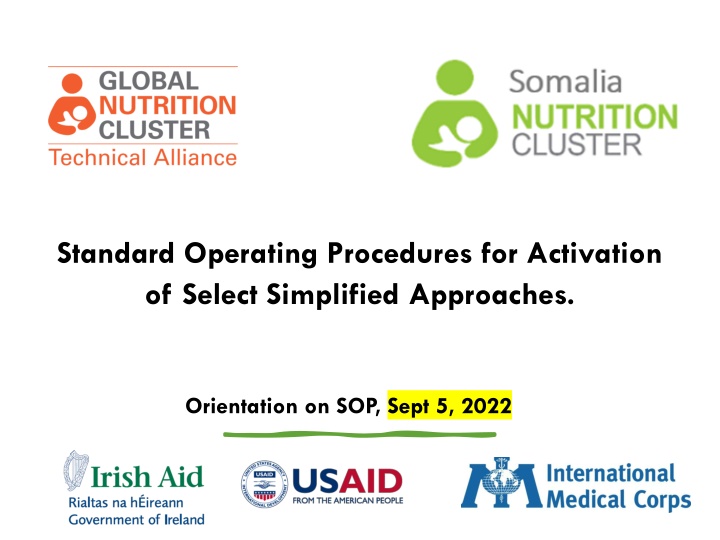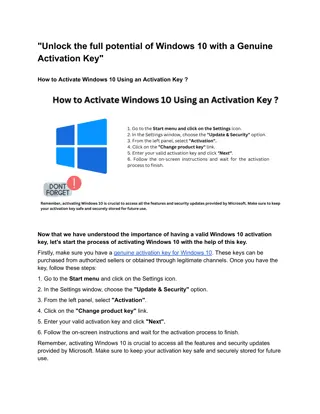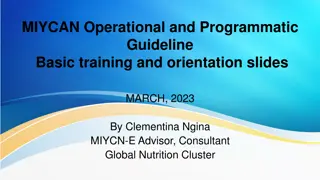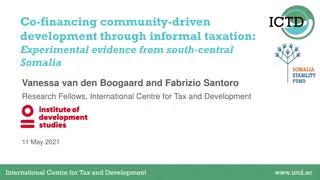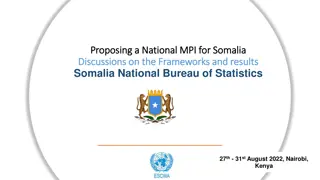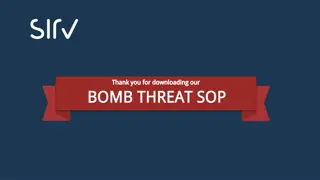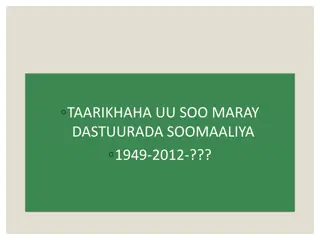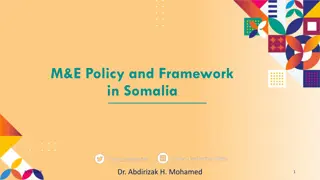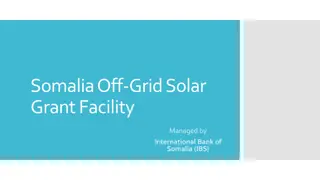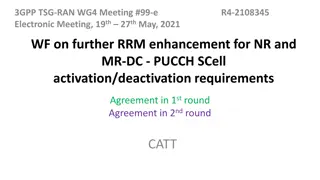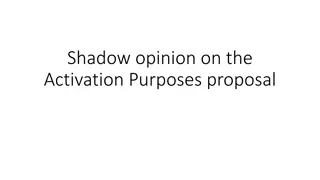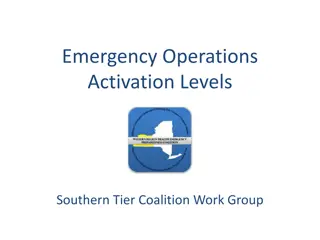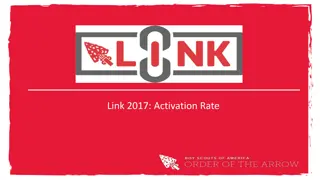SOP Strategy for Activation of Simplified Approaches in Somalia
Explore the Standard Operating Procedures (SOP) guiding the activation of select simplified approaches in Somalia to enhance the management of child wasting. The simplified approaches aim to improve effectiveness, quality, and coverage while reducing costs. The strategy includes tools for implementation within a specified timeframe, addressing challenges like recurrent drought and limitations in existing services.
Download Presentation

Please find below an Image/Link to download the presentation.
The content on the website is provided AS IS for your information and personal use only. It may not be sold, licensed, or shared on other websites without obtaining consent from the author.If you encounter any issues during the download, it is possible that the publisher has removed the file from their server.
You are allowed to download the files provided on this website for personal or commercial use, subject to the condition that they are used lawfully. All files are the property of their respective owners.
The content on the website is provided AS IS for your information and personal use only. It may not be sold, licensed, or shared on other websites without obtaining consent from the author.
E N D
Presentation Transcript
Standard Operating Procedures for Activation of Select Simplified Approaches. Orientation on SOP, Sept 5, 2022
What the simplified approaches? Simplified approaches refer to modifications/ simplifications to existing national and global protocols for the treatment of child wasting. These modifications are designed to improve effectiveness, quality, coverage and reduce the cost of caring for children with uncomplicated wasting. The Simplified Approaches can be used to maintain service availability and continuity in exceptional circumstances until standard programming is established or resumes. This Somalia SOP is adapted from the USING SIMPLIFIED APPROACHES IN EXCEPTIONAL CIRCUMSTANCE Guidelines Published by UNICEF Nutrition in collaboration with the global Simplified Approaches Working Group.
What the simplified approaches? 1. Family MUAC: Engaging family members to screen and refer their children 2. CHW-led treatment of wasting: Management of wasting by Community Health Workers (CHWs) 3. Reduced Frequency of Follow-up Visits 4. MUAC and oedema only: Admission, treatment, discharge based on Mid-upper arm circumference (MUAC) and/or oedema 5. Expanded admissions criteria: Systematic expansions of MUAC to include more children (e.g., 120mm or 125mm) 6. Use of a single treatment product: Use of ready-to-use food (RUF) for the treatment of all wasted children in need of treatment 7. Optimized Dosage: Treatment dosage of RUTF product modified over course of recovery
Why simplified approaches in Somalia? Recurrent drought= high prevalence of acute malnutrition with exacerbating factors. Existing IMAM services affected by pipeline breaks Continuum of care not reached due to low coverage and pipeline breaks Limited resources and capacities. Mitigation measures MoH, NC, UN, partners developed a strategy including the Simplified Approaches
SOP strategy Tool to guide activation, rollout and implementation of appropriate simplified approaches. Current timeframe for implementation = Aug 2022 to June 2023. Can be extended in consultation with the CLA, WFP, MoH and partners. Partners that procure their own supplies should utilize the SOP too.
SOP strategy Overall objective: To improve the quality and coverage of the management of uncomplicated acute malnutrition among children 6-59 months in critical contexts. Specific objectives: To increase the coverage of acute malnutrition treatment services among children 6-59 months in locations with GAM rates 15% presence of aggravating factors with neither OTP nor TSFP services. in the To provide a sustainable continuum of care for the treatment of acute malnutrition in locations with a GAM rate of 15% in the presence of aggravating factors where MAM and/or SAM treatment services are interrupted due to supply, financial or human resources limitations.
Proposed Simplified Approaches in the Context of Somalia Expanded admission criteria of uncomplicated acute malnutrition among children 6-59 months and treatment using a single product: Where the is OTP and not TSFP: Increasing MUAC and weight for height z score cut-offs for admission and treatment in OTP to <125mm and <-1.5 Z score For SAM cases, dosage based on weight as per the national IMAM protocols MAM children given 1sachet of RUTF per day irrespective of weight Where there is TSFP and not OTP Admission criteria based on bilateral pitting oedema(+, ++), MUAC <125 mm and <-2 weight for height z score) in children 6-59 months Treat all cases detected based in above criteria in TSFP SAM children receive 2 sachets of RUSF irrespective of weight per day and MAM cases receive one sachet per day. Visit frequencies are weekly for SAM cases and fortnightly for MAM cases
Other proposed simplified Approaches Family MUAC: Already being promoted and done by some MoH, UN agencies and partners. Community Health Worker (CHW) led treatment of uncomplicated wasting. Currently implemented by some partners but not streamlined Reduced frequency of follow-ups.
Decision pathway Activation of the simplified approaches. Exceptional circumstances Pipeline breaks for more than 2 months Lack of either SAM or MAM treatment services. Hard-to-reach and inaccessible locations Hard-to-reach and inaccessible locations Locations with a GAM rate of 15% with aggravating factors.
Decision pathway: Activation scenarios and adoptable simplified approaches.. Deactivation for scenario 1 pipeline breaks are resolved (supply assured for > 3 months. Establishment of either OTP or TSFP sites in Pipeline break of nutrition supplies* for the treatment of MAM** OR SAM for more than 2 months. or absence of either OTP or TSFP services. locations where expanded criteria were triggered as a result of an absence of either. Expanded Admission Criteria Use of a Single Product in OTP or TSFP Family MUAC AND District with a GAM rate of 10% with aggravating factors. GAM rates have reduced to <10% without aggravating factors Expanded Admission Criteria and Use of a Single Product for treatment Reduced frequency of follow- up treatment: Family MUAC OR GAM rates have reduced <10% with aggravating factors Deactivation for scenario 2 Area has become accessible. OTP and or TSFP established and operational for at least 3 months GAM reduced to 10-14% without aggravating factors Scenario 2 Hard-to-reach and inaccessible locations AND: Lack of either SAM or MAM treatment services. AND: Locations with a GAM rate of 15% with aggravating factors. CHW-led treatment of wasting (integrated into iCCM)
Activation process Initial trigger: changes in the humanitarian context (increased malnutrition, aggravating factors, poor coverage. Creation of a task force (NCC, MoH, UNICEF, and WFP, other) Continuou s monitoring of the evolution of the context NCC desk monitorin g of the implemen tation Approv al of the request Impleme ntation by partner Taskforce review the request Submit a request
Target Beneficiaries: children 6-59 months in special contexts with uncomplicated acute malnutrition Areas of implementation: locations with exceptional circumstances as defined in the decision pathway. Partner selection: Several factors including capacity, access, geographical coverage, Local Vs International, staffing capacity, functionality of OTPs etc. -Will depend on due diligence of the NCC desk
Factors to consider during caseload calculation: UNICEF s RUTF pipeline capacity to support the expected caseload. WFP s RUSF pipeline capacity to support the expected caseloads. The overall nutritional situation and needs Expected duration of implementation of the simplifications (weeks or months).
Roles and responsibilities of stakeholders UN (UNICEF/WFP) Supplies procurement and prepositioning RUTF/RUSF Logistical partners Technical backstopping Knowledge and documentation lessons learned Date on matrix NCC desk Overall coordination Regularly map areas that meet the exceptional circumstances scenarios Orientation of partners Overall monitoring of the nutrition situation Regular updates of partners on Dissemination of the lessons learned Programme, GAM geographical coverage data of support to implementing management of the response rate, and
Roles and responsibilities of stakeholders MoH Implementing partners Support the NCC Desk in the mapping of areas that meet the exceptional circumstances scenarios. Orientation of frontline workers Implementation of the Monitoring and reporting Sharing lessons learned and feedback Key Operational instructions and recommended actions Orientation of frontline workers on the SOP Implementation Monitoring reporting Sharing lessons learned and feedback on the Overall monitoring and
Monitoring and reporting Use existing OTP/TSFO tools NC to have a system to track locations implementing the approaches ONA template to capture MAM cases Data disaggregation by SAM and MAM All children to receive treatment cards Program performance will be based on standard indicators in the national guidelines
Key points Any changes to be done in consultation and coordination with the CLA, WFO, Government, partners Other aspects of care to follow the national IMA guidelines. Living document All partners to adhere to SOP even when using their own supplies Duration of implementation: temporary/3months/dependent on context evolution
